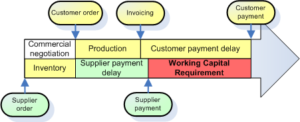Business performance metrics are critical in keeping teams, investors, and customers up-to-date and aware of how a business is performing. But what are these business metrics and what does this mean for your plumbing business? A business metric is essentially a quantifiable measure used to track and assess the status of a specific business process. Every area of your business has specific performance metrics that should be monitored, for example, marketers track marketing in social media metrics such as campaign and program statistics, sales teams monitor sales performance metrics such as new opportunities and leads whilst executives look at the big picture financial metrics.
What about key metrics?
Also known as the key performance indicator, or KPI, a key metric is a statistic that, by its value gives a measure of a business or department’s overall health and performance. Organizations, from non-profits to large multinational corporations need to keep an eye on their key metrics. There are several metrics you can be looking at but finding the right ones can make a huge difference. As a business that directly assists your client base, you have certain KPI’s that connect to your business specifically. Learning how to read the metrics and adjust your strategies effectively can ensure that your benefits continue to grow without problems. Maximizing these profits need you to look at the correct metrics and these include:
Labor cost per employee
This one is not too relevant for smaller plumbing businesses, but it has its benefits. This KPI calculates the expenses of paying employees including overtime, insurance, and so on. Full-time employees who are on salary are paid much differently as compared to a subcontractor.
Director/Owner Salary
Consider recording a market value wage for Director/Owner if they are working within the business. They’ll need to be paid as an employee at market rates. Recording an MV wage will result in an accurate profit for the business.
As a plumbing business, all your employees matter, and you need to account for labor costs to ensure that your skills balance. If the cost is going up, that means you’re doing well. But a decreasing metric indicates that there is likely a person being paid too much or there is an error with the payment system. Possible solutions are to reduce the amount of overtime or consider hiring at lower wages for the overall profits to go up.
Revenue per hour
This metric connects to the labor cost per employee and measures the money earned during work hours. This means that you can check the number of hours that your employees are working against productivity. For a small business such as a plumbing business, it is important to watch this metric because every hour counts. If the metric is going upwards, you might want to consider rewarding your employees and encouraging them further. Pay attention to old successes and hire new employees that have the same values and traits as the old ones. But if the metric is going down, you might need to investigate into your team to find the issue. Depending on your situation you also might need to layoff some employees if improvement does not seem possible.
Gross revenue
This KPI focuses on the total money your business has earned and scrutinizes your sales abilities. Consider any increases or decreases in the profit margins so that you can make any needed adjustments. Check if you will need to hire new employees to increase margins. Ensure that your decisions are fully informed or else you risk unbalancing the whole system.
Net income
This is the bottom-line metric, where you can see how profitable your business is and whether you’re bringing in more money than spending. An increase in this metric means that your business model is functional, and you’ll be able to see what you’re doing correctly. Refer to your previous actions to determine what needs repeating and from there you can create new campaigns to push the profit margins up. A decrease in gross revenue requires investigation to see if this is a continuing trend or a minor setback. If it looks like it’s a continuing situation, adjustments must be implemented quickly. To maximize profits, lower your spending especially if it’s on non-essential activities, and ensure that your employees are being productive.
Working capital requirements
This is sometimes referred to as net-working capital (NWC). It refers to the difference between the company’s current assets (such as cash, accounts receivable (customers’ unpaid bills) and inventory of raw materials and finished products) and current liabilities (such as accounts payable). In simpler terms, this is the value of the required funds that the company needs to retain to be able to repay debts and other business-related expenses. Many factors determine this requirement.
To calculate how much working capital is required, use the following formula,
Working capital = Current Assets – Current Liabilities
The diagram below will also be helpful,

Compare the performance of your plumbing business to these 5 key performance indicators! Download the KPI's so you can always keep an eye on them.

If you need more help understanding your KPI's or to better align with them then feel free to ask us below.


